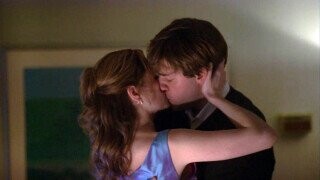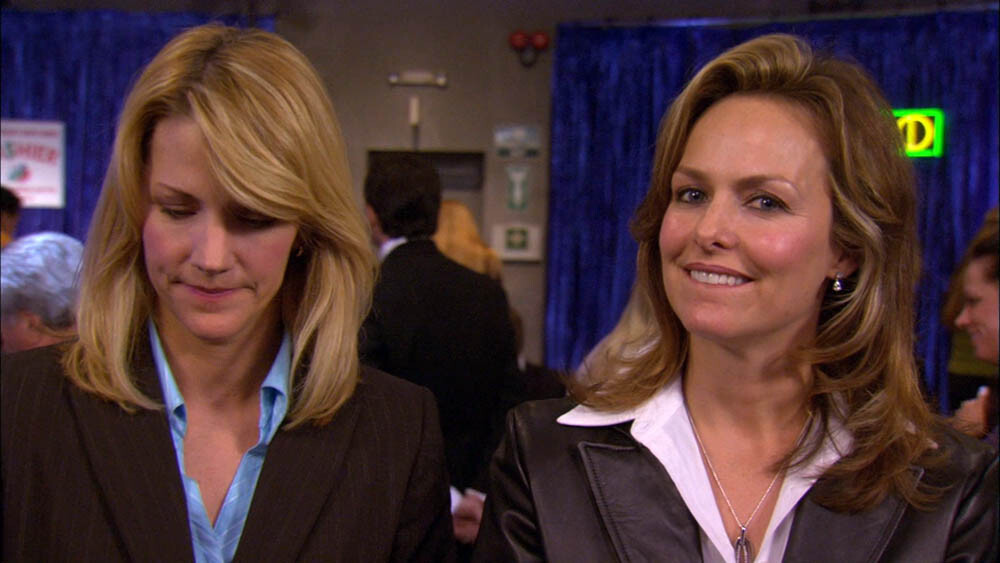'The Office's' Casino Night Episode: Comedy Writing Secrets

We’ve partnered with the legendary Stand Up! Records to offer three winners each a bundle of four comedy specials on vinyl. Vinyl! Enter below for your chance to win and learn more here.
Writing television comedy is about more than writing jokes. (OK, it’s mostly about writing jokes.) But it’s also about writing stories. Multiple stories. And before TV comedy writers get to the jokes, they have to figure out how to keep all those stories straight.
Don't Miss
Enter the beat sheet -- a simple tool that outlines a story’s major events to keep the writers on track. But it’s more than “this happens then this happens then that happens.” It’s a blueprint that makes sure multiple storylines all stay on track.
Let’s break down the essentials of the beat sheet then see how it works in practice with a classic episode of The Office.
ABC, Simple As 123
To create our beat sheet, we’ll use a version similar to one outlined by scriptwriter Kane Wheatly Holder. Without getting too far into the weeds, we’ll keep in mind two simple concepts, represented by 123 and ABC.
The 123 refers to the three act structure most TV comedies follow. In the pre-streaming days (like with The Office), the acts happily coincided with commercial breaks. Each segment of the story -- or act -- generally ended on a mild cliffhanger, providing a natural stopping spot to sell soap and light beer.
The three acts in a thirty-minute television comedy generally look like this:
Act One: This introduces the main story. We keep it simple here -- just set up the main driver of the episode. Something like: Michael needs to fire someone by the end of the day. Or Kelly invites her coworkers to a Diwali celebration. Or Phyllis gets married.
Act Two: The middle act is the longest part of the show, and it’s where we raise the stakes. Characters go through increasingly challenging circumstances before reaching a crisis. As a general rule, the worse the situation gets, the funnier it is. One way to build those beats is by connecting a series of what Holder calls “BUT moments.” For example, at Phyllis’ wedding, here’s how Michael’s story goes from bad to worse in Act Two:
Michael is thrilled that he gets to walk Phyllis down the aisle BUT
Phyllis’ father “upstages” Michael by rising from a wheelchair to walk with his daughter BUT
Michael tries to recapture the limelight with a toast to the bride BUT
Michael’s increasingly cringey speech gets him thrown out of the wedding entirely!

NBCUniversal Television
That’s where Act Two ends -- a moment when characters are furthest from their goals. Michael’s dream of “starring” in Phyllis’ wedding couldn’t be further gone.
Act Three: This is usually the shortest act where everything wraps up and comes full circle. Maybe your characters learned something? Did they get what they wanted after all?
Let’s go back to Michael at the wedding. Cast out, he sits outside in the dark with demented Uncle Al, a relative who’d gone missing during the ceremony. The two men talk as the wedding party emerges. Michael rises to apologize to Phyllis, who now believes Michael is the one who found Uncle Al! She kisses Michael on the cheek and thanks him.
From the dark to the light -- Michael not only learned a lesson (he shouldn’t have tried to make the day about him), but he also helped make Phyllis’ wedding a happy success.
But Michael’s story was only one of the storylines in that episode. Let’s now look at A, B, and C stories.
The Office, like all television comedies, has multiple storylines that run through an episode. We’ll label them A, B, and C with the A story representing the main action, and B and C standing in for smaller stories told throughout the episode. (Sometimes there will only be an A and B story; other times there may be a D and an E. But you get the idea.)
This is where the beat sheet becomes essential! Laying out each of the script’s main story actions lets you know when you’ve abandoned the B and C stories for too long.
Back to Phyllis’ wedding. Let’s say this episode has three main storylines, which we'll label A, B, and C:
A: Phyliss is getting married -- we’ll see the preparations, the ceremony, and the celebratory party after.
B: As the stand-in “father of the bride,” Michael tries to make the day all about him.
C: Pam’s day is miserable -- Phyllis stole all her wedding ideas, and Jim is happy with his date, Karen. Her misery leads her back into a relationship with Roy.
Each story will have its own Act One, Act Two, and Act Three beats. Making sure each story plays out all of its required ‘beats’ ensures a funny show that also works to build suspense and develop characters.
Beat Sheet: ‘Casino Night”
So what does an actual beat sheet look like? Let’s work out a beat sheet for the Office episode Casino Night, the Season Two finale. There are a number of running subplots throughout the episode, but let’s label these our three main storylines:
A: The Scranton branch holds a casino night to raise money for charity.
B: Michael accidentally invites two dates.
C: Jim and Pam escalate their flirtation, leading to Jim’s confession of love. (in some ways, this C story has been building for two seasons.)
With no further preamble, here’s what a beat sheet might have looked like for ‘Casino Night.’ Note how the writers bounce from A to B to C.
Casino Night Act One - Setting up the Premise
A: Michael sets the stage for Casino Night. “We are converting our warehouse into a full-blown gambling hall. And I know it's illegal in Pennsylvania, but it's for charity.”
B: Michael invites Jan to the event. She hangs up on him, dashing Michael’s hopes for romance.
A: Michael and the staff discuss which charities they’ll support. Not everyone sees eye to eye. Whoever wins the most chips gets to donate $500 plus a mini-fridge from Vance Refrigeration!
C: Jim offers to help Pam pick wedding entertainment, a responsibility that Roy is neglecting.

NBCUniversal Television
C: Pam tells the camera that she’s pretty happy these days, getting married soon and “getting along with everybody at work.” But in Jim’s talking head, we see he feels the opposite: He hints at a transfer since he “has no future here.”
And there’s our cliffhanger! Will Jim really leave Pam behind?
Casino Night Act Two - Raising the Stakes
A: Preparations for Casino Night struggle as Darryl refuses to let Michael have fire-eaters in his paper warehouse.
C: Jim and Pam watch tapes of bands (including Kevin’s Police cover band, Scrantonicity). The flirt game is hot and heavy.
B: When Carol needs a signature from Michael, he invites her to stop by at Casino Night. Before she accepts, a call from Jan comes through -- she has decided to come after all. Then Carol accepts Michael’s invite as well. Two dates in one night! Consider the stakes raised.
A: It's Casino Night and everyone is playing games.
B: Carol arrives, greeted awkwardly by Michael with multiple kisses on the cheek.
A: More Casino Night fun: Creed steals everyone’s chips; Michael welcomes everyone to the festivities; Toby cleans out Michael in poker after an ill-advised bluff attempt; Jim fakes out Dwight.

NBCUniversal Television
B: Jan arrives and Michael makes an uncomfortable situation even more awkward by confessing his sins. Jan ruefully accepts the situation.
C: Pam and Jim flirt over cards.
B: Jan and Carol get drinks, exchanging passive-aggressive barbs. If it was awkward before, it’s actually strained now.

NBCUniversal Television
A: Phyllis beats poker expert Kevin.
B/C: Jan and Jim find themselves in the parking lot, lamenting their failed relationships. Jim implies he is going to transfer and leave Scranton forever.
A: Creed the cheater wins the refrigerator.
C: Roy leaves Jim and Pam in the parking lot, where Jim finally confesses his love. Pam, torn by her commitment to Roy, shuts down Jim.
The stakes don’t get raised much higher than this. Jim finally risks it all -- and gets a white-sneaker kick right to the heart. Jim's character is now at an all-series low, taking his biggest risk and receiving no reward. Pam is also at her darkest moment. By shutting down Jim, she’s likely lost her best friend.
Note the BUTS in Michael’s story during Act Two: Jan says yes BUT so does Carol, leaving Michael with two dates BUT Michael’s awkward confession seems to resolve the problem BUT Jan and Carol still clearly have it out for each other.
Finally, we’ve landed on a second cliffhanger: Are Pam and Jim really done forever?
Casino Night Act Three - Triumph or Failure
A/B: Jan leaves, congratulating Michael on a successful Casino Night (and wrapping up our A Story). What could have been a disastrous evening turns out to be one of the best of Michael’s life. “The hero got the girl. Who saw that coming? I did. And Jan was really happy for me. So actually the hero got two girls.”
B: Of course, Jan is not happy for Michael. She leaves in a huff, noting the overnight bag in her car. Total defeat -- how could she have been this stupid?
C: In the office, a distraught Pam confesses everything that just happened with Jim to her mom on the phone. Jim enters the darkened room and Pam hangs up. They kiss! And the season ends.

NBCUniversal Television
In an unlikely turn of events, Michael’s evening was a romantic success. And in the space of a couple of minutes of screen time, Jim goes from his darkest moment to fulfilling his wildest dream by kissing Pam (and Pam kissing him back). For now, two seasons’ worth of obstacles and complications are thrown to the side as Jim achieves his heart’s desire.
The final scene also serves as a cliffhanger for the entire season. We’ll have to wait for Season Three to see what comes next.
Comedy Writing Takeaways
Hopefully, we just did more than write out a “here’s what happened” for Casino Night. By reverse-engineering a beat sheet for this episode, we can see how this tool helps comedy writers finetune their scripts in the following ways:
1. The beat sheet shows how the writers pinball their way back and forth through the A, B, and C stories. Without this tool, writers may find they’ve just gone 15 pages without returning to one of the subplots! Working out the A/B/C cadence makes sure all stories are properly told.
2. Breaking the script into three acts helps finetune each storyline so it's as dramatic and funny as it can be. Each turn in Michael’s “two dates” story takes an awkward situation and dials up the cringe -- and the more Michael and Jan suffer, the more we laugh.
3. Finally, the beat sheet helps us find the lowest possible moment for Pam and Jim at the end of Act Two, only to swing it completely the other way for our Act Three close. The lower we can take the characters in Act Two, the higher we can land at the end of the story.
Want to take a stab at writing your own sitcom? A beat sheet is a great place to start. (But yeah, you’ll also need to write jokes.)
Top Image: Deedle-Dee Productions
For more ComedyNerd, be sure to check out:
Cracked VS: Why the BBC Office Should Get Promoted Over the American Office
'The Office's Todd Packer: Is He Even Funny?
Chris Farley And The Comedian Who Ignited America’s First Sex Scandal
